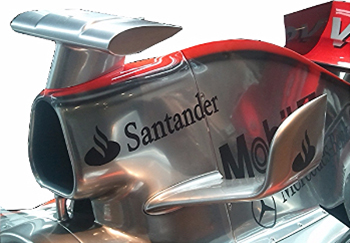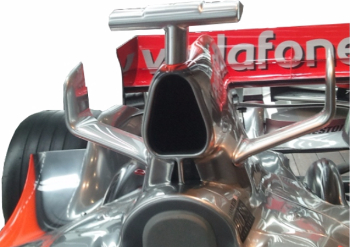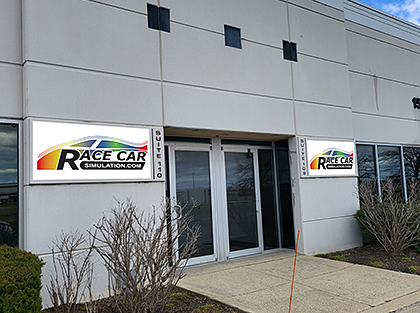CFD – Aerodynamics

Aerodynamics – CFD Analysis
We provide Engineering Analysis of fluid flow over a body, wing or component. We can work from a drawing, CAD file or can scan the geometry of your car or component. A standard analysis includes a report including the following information:
- Drag Force
- Down Force
- Drag Coefficient
- Pressure Coefficient
- Pressure Contour Plot
- Velocity Contour
- Velocity Streamlines
Aerodynamic Analysis From Pictures

Side View and Front View Drawn and Scaled in Cad System

Solid Model Geometry Created from Front and Side Views

Aerodynamic Analysis of Main Section

Vector Plot Showing Patterns of Separation
Land Speed Record Racer:
Open Wheel Aerodynamics

Aerodynamic Air Boxes:

Aerodynamic air boxes are used in open wheel racecar designs, in order to supply air to the intake system of the engine, general aerodynamics of the body and even driver safety.
Important in terms of aerodynamic effectiveness and engine performance. The air box needs to have cold air to feed the engine, which does carry drag penalties to some degree and external design is vitally important.
The whole design centres around “Ram Effect”, which forces air into the air box, the faster you drive, the more air is forced into the device. The air entering the device is forced to enter a small opening, effectively speedy up the air molecules and making them travel faster (low pressure), in order for the air to enter the air box opening. Once air enters the intake, the aerodynamic air box widens in diameter, this has the effect of slowing down the air speed (increasing pressure). The air intake is now more dense, with a higher oxygen ratio, this allows more fuel to be added to the combustion chamber- resulting in increased engine power.
Aerodynamic air boxes are another device which in F1 terms is subject to governing body restrictions. Over the Years the air box has changed and evolved, to include wing-lets and various aero devices. This means that the function of the air box evolves from a way just to feed the engine air, to a down force generating device as well.

As safety has become top priority for drivers, the roll-cage or crash structure is normally incorporated into the design- in the event of the racecar over tuning.
If the overall design has poor aerodynamic efficiency, flow separation could occur, which will have a negative effect on the rear wings´ down force levels and overall drag penalties. This will result in slower lap times due to decrease top speed on the straights, also braking and cornering capacities.
We have seen the overall design change rapidly over the various regulations, especially in F1.
Aerodynamic Suspension:
Aerodynamic suspension is critical in maximising frontal airflow efficiency to channel smooth airflow to the rear of the car, in open wheel racing cars. Closed wheel racing cars are enveloped by body work and normally closed in under-bodies, so this has less of an effect.

Aerodynamic suspension helps to increase overall down force levels for the whole aerodynamic package. If we have airflow separation at the front of the car, this could easily reduce the whole aerodynamic package, or at least negate some of the down force generation potential.
Aerofoil shaped front wishbone and steering arms help to realise this by keeping laminar airflow in check, while not promoting flow separation, as this will also lead to increased drag levels. The devices take on a side profile of a aero-foil to a certain degree, with minimal drag and smooth laminar airflow as their prime objectives.
Normally constructed from carbon fibre for its light weight and strength proprieties. The lightly increased mass compared to a cylindrical design, is totally overcompensated by the performance gains achieved through better aerodynamic efficiency.
Barge Boards and Guide Vanes:
Barge boards and guide vanes are used almost extensively in open wheel racing car series. Air which leaves the front of the car can be turbulent, from the front wing, tyres and aerodynamic suspension parts. Barge boards and guide vanes are used to help and direct and channel air in a smooth and laminar manner, to the remaining rearward sections of the racecar.
Vertical or sometimes horizontal plates in design, they are normal mounted within the front suspension or just behind it. These devices were introduced in the 1994 F1 championship, following a mandatory reduction in front end-plate dimension restriction. This left undesired airflow characteristics, which had a negative effect of the aerodynamic package.
Very similar in concept to the front wing end-plate function, the aim was to smooth out and channel turbulent airflow to the rearward aerodynamic devices. By tidying up the front wings assembly's “wake” or dirty airflow, results in less airflow separation, which causes drag- which in turn impacts overall top speed potential. Whiles also impacting the rear aero devices ability to create more downforce.
While this device maybe be small in comparison to other aerodynamic downforce generation devices- we have seen that its impact on the overall package has big benefits.
DRS ( Drag Reduction System):

A drag reduction system ( DRS) or rear movable wing as some might know it, is a way in which the rear wing's angle of attack can be adjusted for better straight line speed. Essentially a lever which controls one of the rear wing flaps, normally operated during the straights, it's one of the ways in which F1 has adopted new design rules to spice things up in the 2011 season.
The greater the rear wing's angle of attack, the more downforce is generated. By reducing this angle of attack, the wing reduces downforce and drag levels, increasing top speed as a by product and aid overtaking.
In F1 this system is controlled electronically via a FIA approved ECU system and is normally permitted when the leading car is with in a 1 second gap. Speeds of up to 12km per hour are suppose to be the limit of this device, but arguable tracks with more downforce settings could reap larger gains.
Nose Cone:

The front nose cone, as seen on open wheel designed racecars, are an effective way to mount the front wing and minimise frontal area. While designs in certain race formats may change from season to season, governing bodies have a challenge on their hands reigning in ever more sophisticated design evolution.
While design configuration in nose cone design in its infancy promoted horizontal wing attachment to the sides. The introduction of high mounted design with wings under slung is the universal norm these days. First seen in Tyrrell and Migots of the 1990's F1 Championships.
This design promotes under-tray and rear diffuser airflow optimisation, promoting reduced drag and increase down force potential.
Rear Wheel Scallops:
Added to the rear of the car, just in front of the rear wheels, scallops help to smooth and channel air to the rear diffuser and around the wheels. Located normally under the winglets, at the end of the side pods.
Side Pods:
Side pods not only act as a critical housing for the cooling system, including oil and water radiators, but also serve as a life saving safety device. The internal shaping has to maximise thermal transfer rates and reduce drag penalties, which can be a balancing act in its self. But also be a deformable structure to help protect the driver in side collisions.
The design normally incorporates chimneys and cooling louvres help to extract hot air as quickly as possible. Vitally important in hot and humid conditions, especially in F1 where there is no electric cooling fan for the radiator.
General design of the side pods where quite tall and boxy in the beginning, but with ever increasing aerodynamic evolution, modern designs lend to be lower and sleeker. As designers strive for less drag and more down force, at the rear of the car where the biggest gains can be made.
Under-tray:
Under-trays or under-bodies and underfloor as they are commonly known. Are one of the most important drag and downforce critical aerodynamic components of the whole racecar design especially in racing series such as F1.
Since the discovery of “ground effects”, some 60% of potential down force generation can be achieved with these devices on open wheel racing series- depending on the regulations.
Not actually part of the chassis's structure's strength, it is a full length carbon fibre and mandatory “jabroc” wooden board incorporated aerodynamic device.
The Jabroc wooden board in F1, is checked by scrutineers after races to make sure wear rates are intact, in an aid to reduce team's ride heights and down force generation potentials.
It is mounted to the flat underside of the car to smooth and channel airflow to the rear diffuser. Subject to many rule and regulatory mandates, this device has changed and evolved with many technological advances.
Winglets:
Winglets are devices which are mounted to sidepods to help to increase downforce generation levels, suited to tight and twisty tracks. Aiding in rear end grip to maximise both cornering forces and traction out of tight corners. Winglets alos have the role of helping to direct and channel airflow over the rest of the Racing car's body and aerodynamic devices.
 Address:
Address: